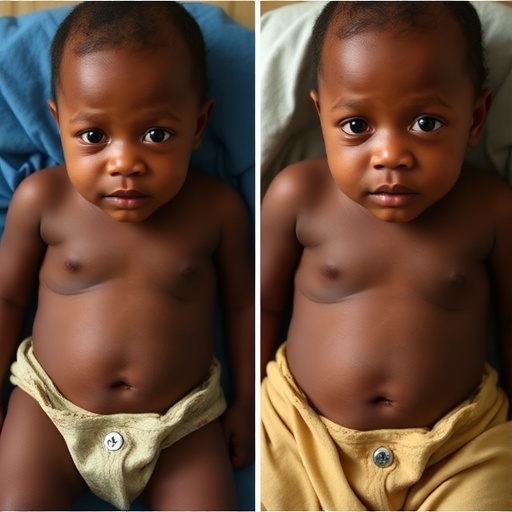Anorectal malformations (ARMs) represent a significant congenital anomaly in pediatric surgery, posing both clinical challenges and emotional strains for families. In Eastern Africa, where healthcare resources may be limited, understanding the surgical reconstruction and the subsequent functional outcomes of children suffering from ARMs is crucial. A comprehensive five-year study conducted by Kisaka, Kyaruzi, Ngotta, and their colleagues sheds light on the surgical practices and outcomes in this region, emphasizing the factors influencing recovery and ultimate success.
The study aims to analyze the various surgical techniques employed during the reconstruction of anorectal malformations, detailing the methods and approaches adopted over five years. Surgeons in Eastern Africa face the unique challenge of tackling this debilitating condition amidst a backdrop of limited resources and diverse patient needs. The authors meticulously documented the types of procedures performed, ranging from simple repairs to more complex corrective surgeries, imparting valuable knowledge on the practicality and efficacy of various surgical interventions.
What unfolds is a thorough examination of how these different surgical approaches relate to patient outcomes. The authors explore not only the immediate success of surgical reconstruction but also the long-term functional status of patients. This retrospective analysis observes children’s subsequent bowel function, continence, and overall quality of life post-surgery, providing a holistic view of the efficacy of treatments offered in the region.
Furthermore, the researchers emphasize the necessity of a multidisciplinary approach in managing anorectal malformations. Collaboration among pediatric surgeons, gastroenterologists, and pediatricians is paramount for developing tailored treatment plans that genuinely meet each child’s unique needs. The insights presented in this paper underline the importance of not only timely surgical intervention but also ongoing care and monitoring from a specialized medical team.
The study notes that early diagnosis and surgical intervention can drastically improve outcomes in children with ARMs. However, factors such as patient age, the presence of associated anomalies, and even socio-economic conditions play a significant role in determining the odds of a successful outcome. This nuanced understanding of the multifactorial conditions surrounding each case is instrumental for medical professionals engaged in this field.
In terms of complications, the researchers report a range of post-operative challenges encountered during the study. From infections to functional issues like constipation and fecal incontinence, the spectrum of complications highlights the need for careful patient selection and follow-up. The authors advocate for more rigorous post-surgical monitoring to help identify and address any arising complications swiftly, thereby improving the overall success rates of surgical management.
Patient education also emerges as a vital component of the care continuum. Families often experience anxiety and uncertainty surrounding the surgical process and potential outcomes. By deploying educational initiatives and support systems, healthcare providers can enhance parents’ understanding and confidence, ultimately leading to better compliance and follow-through with post-operative care.
The study also presents a comparative analysis to similar international cases, revealing that the challenges faced in Eastern Africa are, in many ways, reflective of broader trends in global pediatric surgery. While some regions may have more advanced technologies and surgical techniques, the fundamental issues surrounding patient care, follow-up, and comprehensive treatment remain universal. By sharing their findings with the broader medical community, the authors hope to inspire advancements in practice and reinforce the need for global cooperation in addressing ARMs.
Particularly notable is the acknowledgment of the resource constraints that often dictate the nature of surgical interventions in Eastern Africa. The study underscores the commitment of local healthcare providers to innovate within their means. Surgical teams often have to improvise with the tools and technologies available to them, adopting pragmatic solutions to address complex problems in life-saving procedures.
The implications of this research extend beyond surgery, touching on essential healthcare policies that govern pediatric care in developing regions. As healthcare systems strive to improve, findings such as those presented in this study make a compelling case for allocating resources toward the training of healthcare professionals and the expansion of surgical facilities. This investment is vital in bolstering surgical capabilities and improving health outcomes for children with congenital anomalies.
Moreover, public health initiatives aimed at raising awareness around ARMs are essential, highlighting the importance of early medical intervention. Campaigns focused on educating communities about the signs of anorectal malformations can drive home the importance of seeking urgent care and potentially save many children from preventable complications.
In conclusion, the intricate journey of children with anorectal malformations in Eastern Africa is one marked by the resilience of both patients and healthcare providers. The study by Kisaka and colleagues not only highlights the technical aspects of surgical reconstructions but also paints a vivid picture of the human side of battling congenital anomalies. Through comprehensive care, ongoing support, and a robust healthcare framework, it is possible to significantly enhance the functional outcomes and quality of life for affected children.
This research represents a vital contribution to the field of pediatrics, combining clinical findings with a poignant narrative that reflects both the scientific and humanitarian efforts in addressing congenital disorders. As the medical community continues to build on these findings, a hopeful outlook emerges for improvements in both the surgical management and holistic treatment of anorectal malformations around the globe.
Subject of Research: Anorectal Malformations in Pediatric Surgery
Article Title: A Five Year Experience of Anorectal Malformation Surgical Reconstructions and Functional Outcome Associated Factors in Eastern Africa
Article References: Kisaka, J.M., Kyaruzi, V.M., Ngotta, V. et al. A five year experience of anorectal malformation surgical reconstrunctions and functional outcome associated factors in Eastern Africa.
BMC Pediatr 25, 936 (2025). https://doi.org/10.1186/s12887-025-05560-5
Image Credits: AI Generated
DOI: https://doi.org/10.1186/s12887-025-05560-5
Keywords: Anorectal malformations, pediatric surgery, surgical reconstruction, Eastern Africa, patient outcomes.
Tags: Anorectal malformations surgerybowel function assessmentcongenital anomalies in childrencontinence improvement in ARMsEastern Africa healthcare challengesemotional impact on familiesfunctional status after surgerylong-term patient outcomespediatric surgery outcomesretrospective analysis of surgical interventionssurgical practices in limited resource settingssurgical reconstruction techniques





